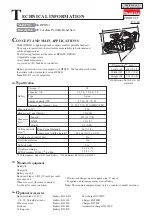
- 58 -
6
NORME DI FUNZIONAMENTO • OPERATING PROCEDURES
ENGLISH
ITALIANO
024_057_0.tif
16
A
B
6.4.3 Uso corretto delle lame
circolari
Assicurarsi che la macchina sia
ben piazzata in modo da evitare
dannose vibrazioni.
Evitare di ritirare il materiale quan-
do il taglio è già iniziato; procedere
con un avanzamento continuo
senza strappi.
La velocità di avanzamento del
pezzo contro la lama, special-
mente in corrispondenza dei nodi,
non deve essere veloce e deve
essere rapportata allo spessore
dello stesso.
Non fare sostare i pezzi fra guida
sega e lama
Rimuovere sempre i rifi li che si
creano durante la lavorazione in
quanto potrebbero inserirsi fra la
lama e il copriforo creando danni
alla macchina o pericolo per
l'operatore.
Prima di eseguire la rimozione
spegnere la macchina e attendere
che la lama sega sia ferma.
Non urtare le placchette contro
oggetti metallici.
Quando i taglienti perdono il fi lo,
riaffi lare subito la lama.
Pulire spesso il corpo d’acciaio e
le placchette dalle incrostazioni
usando gli appositi liquidi in com-
mercio. Lasciare a bagno la lama,
poi pulire con spazzola vegetale.
Non usare spazzole metalliche.
Scegliere la dentatura ricordando
che per avere un buon taglio è ne-
cessario che almeno 2-3 taglienti
lavorino nello stesso tempo
A
(fi g. 16). Se lavora un solo tagliente
B
(fi g.16) non si ottiene un buon
taglio.
È inoltre importante, quando è pos-
sibile, sollevare la lama fi no a fare
sporgere dallo spessore del legno
tutto il tagliente del dente.
6.4.3 Correct use for circular
saw
First make sure that the machine
does not vibrate.
Do not try to take off the material
when the cut has already started;
proceed with a continuous and
uniform speed.
Workpiece feeding towards the
blade (especially where there are
knots) should not be too fast (fee-
ding speed should be in accordan-
ce with workpiece thickness).
Do not let workpieces stop betwe-
en the saw fence and the blade.
Always remove any trimmings
produced during machining
because trimmings interposed
between the blade and the hole
covers might damage the machine
or be a source of danger for the
operator.
Turn off the machine and wait for
the cutting blade to stop before
removing.
Avoid contact of the tips against
metallic objects.
When necessary sharpen the saw
blade.
Often clean the steel body and the
tips with proper liquid products. Let
the saw blade in the bath, then cle-
an it with brush: don’t use metallic
brushes.
As regards the toothing at least
2-3 teeth shall cut at the same time
A
(fi g. 16).
If only one tooth cuts
B
(fi g. 16) you
don’t get a good cutting.
Whenever this is possible, it is also
critical to lift the blade until the
whole tooth cutting part protrudes
from the wood thickness.
















































